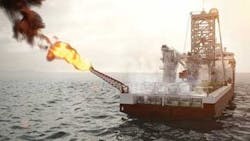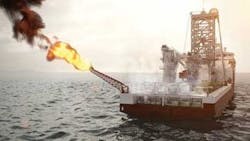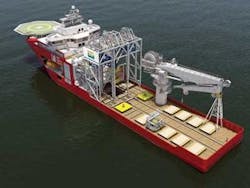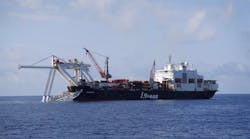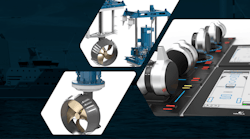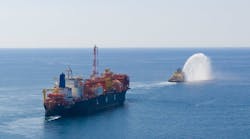Nick Terdre - Contributing Editor
A step-change in subsea well intervention is imminent. Aker Oilfield Services has ordered four newbuild vessels to extend the range of services it plans to offer. The first, due for delivery in early 2010, already has a long-term contract with Petrobras.
Cost-effective subsea well intervention is critical for the offshore industry for several reasons. One is the rapid increase globally in subsea production wells, many of them in deep waters. Another is the need to tap additional reserves – recovery from subsea wells is currently around 30-40% lower than from platform wells.
Other factors driving developments in intervention are the need for production worldwide to keep pace with growing demand, and the growing restrictions on international oil companies trying to access new reserves.
Traditionally mobile drilling rigs provide the platform to maintain subsea wells, but as day rates have climbed, oil companies are increasingly keen to reserve rigs for the core business of drilling. Alternative solutions for subsea well intervention are therefore in strong demand.
So far the service industry’s response has been limited to the provision of light well intervention services from monohull vessels, says Erik Norbom, chief technology officer for Aker Oilfield Services. Also, these services have been applied only in water depths of up to 450 m (1,476 ft). Aker, however, is designing its new service for all water depths up to 3,000 m (9,842 ft). “Our mission is to come up with a solution which is also attractive in price and therefore helps increase the frequency of intervention operations,” says Norbom.
That solution involves an expanded range of services delivered from monohull vessels specially designed for this task. The aim is to provide these services for about half the equivalent cost using a drilling rig. While the latter is essential for drilling and installing tubing, Aker also envisages its vessels taking on other tasks such as through-tubing drilling and well clean-up.
Development background
Aker Oilfield Services, which is owned 77% by Aker group companies and 23% by DOF Subsea, was established in 2006 to provide improved oil recovery services for subsea wells. Its partners within the Aker group are Aker Solutions and its subsidiary Aker Well Service, and Aker Qserv, an Aberdeen-based provider of well intervention services which was acquired in 2008. Offshore ship owner and operator DOF Subsea and well services company Expro also are participating.
Aker Solutions has been developing subsea well intervention technology and providing associated operations personnel since the early days, according to senior vice president for business development and technology, Erik Taule. Its achievements include open-water workover systems that dispense with the need for the 21-in. (53.3-cm) marine riser traditionally applied to encase the high-pressure riser used to flow oil from the well.
The company is providing wireline services and equipment for both light and heavy intervention from drilling rigs on several fields, including the Troll Oil field and the high-pressure, high-temperature Kristin field in the Norwegian sector, both operated by StatoilHydro. In partnership with Island Offshore, it is also a leading provider of monohull-based wireline intervention services.
The rig-based operations employ modular well control packages which have been repackaged for use on monohull vessels, and these form the basis for the packages to be used in the new service, Taule says.
Services to be offered by Aker Oilfield Services and its partners are as follows:
- Subsea intervention: The installation, testing, and maintenance of subsea modules and top-section downhole equipment
- Riserless well intervention: Logging, reperforation, zonal isolation through plug-setting and removal
- Riser-based intervention: Coiled tubing and wireline operations, well testing and clean-up, chemical injection, circulation, sand removal, push force, and scale milling
- Light drilling: Through-tubing drilling with coil and downhole motor, through-tubing rotary drilling with slim-pipe, and managed-pressure drilling.
These services will be provided from dedicated monohull intervention vessels based on designs developed by Aker Yard, now STX Europe, to meet specifications provided by Aker Oilfield Services and Aker Solutions.
An order has been placed with the shipbuilder for four vessels, plus two options. These vessels, to be operated by DOF, are being built to the offshore subsea construction vessel designs OSCV 03 and OSCV 06. Both designs are unusually long – OSCV 03 is 121 m (397 ft) and OSCV 06 is 157 m (515 ft). In the latter case, this allows the 06 to ride three wave lengths at a time. Model tank tests at the Marintek facility in Trondheim, Norway, confirmed that this feature improved the vessel’s stability, which translates into longer uptime.
Another unusual feature is the lowered bow, in which the helideck is contained. Most offshore support vessels have the helideck above bridge level, but in this case the bridge overlooks the helideck. That should make helicopter landings easier and also possible in worse sea states than with a conventional, high-up helideck.
Behind the bridge is a large deck area supporting a moonpool, derrick, and crane, with ample room to carry equipment and perform operations. The OSCV 03 has a deck area of 1,300 sq m (13,993 sq ft) while the OSCV 06 has a deck area of 2,100 sq m (22,604 sq ft) and a deckload capacity of 7,000 metric tons (7,716 tons). Accommodation capacity is for 120 on the OSCV 03 and 140 on the OSCV 06. Both vessels have DP-3 dynamic positioning capability and are equipped with two work-class ROVs. OSCV 06 has a transit speed of 19 knots, enabling it to move swiftly between locations.
The current building program involves one OSCV 03 vessel and three OSCV 06 units. The hulls for the four vessels have been contracted to STX Europe’s shipbuilding facility in Romania. The OSCV 03 will be outfitted at Aukra and the three OSCV 06 vessels at Sørviknes, two yards on the mid-Norwegian west coast.
Recently the hull of the OSCV 03 unit was on its way to Aukra, while construction of the hull of the first OSCV 06 was well advanced and steel was being cut for the second. The OSCV 03 is due to be delivered in early 2010, and the OSCV 06 vessels later in 2010 and in early 2011.
Differing roles
The two designs are intended for somewhat different functions. The OSCV 03 is classed as a construction vessel, while the OSCV 06, which will undertake operations involving oil on deck, is classed as a mobile offshore drilling unit (MODU).
For Petrobras, the OSCV 03’s primary role will be as a subsea equipment support vessel (SESV), a concept originated by the Brazilian company and further developed in cooperation with Aker Oilfield Services. This designation does not involve well intervention as such, but does mean taking on work traditionally performed by drilling rigs, in particular installing subsea trees.
The trees employed by Petrobras consist of three main parts: a production adapter base, christmas tree, and an external tree cap. Three runs are therefore needed to install the entire tree, and for a drilling rig running each part on the drill-pipe in, for example, 2,000 m (6,562 ft) of water, the whole operation typically takes several days.
The SESV, however, runs each part guideline-less on fiber rope, using a specially designed installation tool. According to Norbom, it should take no more than around one hour for each run; but even if it takes a little longer in practice, the time-saving still will be substantial.
The SESV also will perform light marine construction – what is referred to as subsea intervention – and tie-ins. It is capable of landing modules weighing up to 125 metric tons (138 tons) in 2,500 m (8,202 ft) water depth. Tooling for the installation of subsea trees and for subsea intervention operations is being developed by Aker Solutions.
Multi-assignment capability
In size the 06 design is not far short of a small drillship, Norbom points out. Its equipment includes a top-drive system for the drilling functions. Riser work will be performed with high-pressure workover risers – a 7-in. (17.8-cm) riser for water depths to 2,000 m, and 5-in. (12.7-cm) for deeper operations to 3,000 m.
Aker Oilfield Services designed the vessel to be multipurpose – its attractions are enhanced if clients know it can be deployed on other tasks when the flow of subsea well intervention work is interrupted. The design therefore also includes a 400-metric ton (441-ton) crane, providing the capability to install structures weighing up to 225 metric tons (248 tons) in water depths to 3,000 m. This also allows the vessel to be self-sufficient when lifting heavy equipment on board, a big advantage when operating in areas short of local infrastructure, Norbom says.
The OSCV 06 also is equipped for well testing and clean-up, functions typically performed by drilling rigs. It is fitted with a flare at the stern for burning off produced hydrocarbons. Using the vessel for this task can save 10-14 days’ rig-time, he adds. The facilities will have capacity to produce up to 20,000 b/d of oil and 4 MMcm/d (141 MMcf/d) of gas.
In both new vessel designs, operations are managed from one integrated control room. Here there are three main control chairs – one for wireline and coiled tubing operations, another for well control, and one for the topsides equipment. Other work stations are assigned for handling third-party equipment, tooling, and so on. “In other words,” says Norbom, “all the control operators are sitting in one room, talking together, and looking at the same screens.” In this way, integration of operations should be more efficient and safer.
Potential clients have responded positively to presentations of the overall subsea well intervention concept, he adds. “They can see the possibility of significant cost savings.” He is optimistic of winning further contracts by the time the vessels come into operation.
Clients seem to have in mind long-term charters of at least five years. Typically these might be the larger international oil companies with a substantial inventory of subsea facilities to maintain. But Aker Oilfield Services says it is open to collective contracts with groups of smaller companies, along the lines of the multi-client drilling rig contracts common today.
